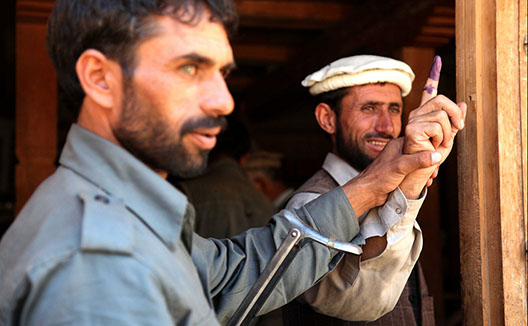 South Asia is currently witnessing the “largest democratic event in the world” with 7 million, or 60% of registered voters, visiting the polls in Afghanistan last weekend, and the first wave of 815 million registered voters begin to vote this week in India’s five week parliamentary elections. South Asia Center Director Shuja Nawaz and Senior Fellow Mohan Guruswamy reported on the region’s momentous events from New Delhi, with Deputy Director Bharath Gopalaswamy reporting from Bangalore.
South Asia is currently witnessing the “largest democratic event in the world” with 7 million, or 60% of registered voters, visiting the polls in Afghanistan last weekend, and the first wave of 815 million registered voters begin to vote this week in India’s five week parliamentary elections. South Asia Center Director Shuja Nawaz and Senior Fellow Mohan Guruswamy reported on the region’s momentous events from New Delhi, with Deputy Director Bharath Gopalaswamy reporting from Bangalore.
Immediate reports of the Afghanistan election suggest a “success of the Afghan people,” stated Nawaz. Irrespective of Taliban threats and even monetary incentives from the Taliban to deter voters, Afghans lined up throughout the country to exercise their right to vote, “a reflection of what appears to be a clearly massive demographic shift in the Afghan population.” Though the voting preferences of women, youth, and the urban population remain unclear, Nawaz contended, “the interconnectedness of youth and people in the city through cell phone technology in particular may have galvanized people to vote.”
While Afghanistan’s votes are still being counted, many are predicting a run-off election between the apparent frontrunners, Abdullah Abdullah and Ashraf Ghani Ahmadzai. The general sense surrounding this election, Guruswamy argued, is that “people in Afghanistan are not going to vote on tribal lines, they will vote to choose a man.” Both assumed leaders are well known in the United States, the region, and throughout Afghanistan, and will face the massive challenge of keeping Afghanistan stable. However, Guruswamy contends, “whoever wins, it doesn’t matter. The challenges and opportunities facing the new leader in Kabul remain the same, and lead to the candidates aligning on the major concerns facing the electorate. Rather, the relative peace and impressive voter turnout suggest a change in Afghanistan and a new era for the region. As Guruswamy states, “this is a moment of hope in the region—a great moment to seize and build on something new.”
Similar trends are expected over the course of India’s five week parliamentary elections. Half of the registered voters are estimated to be below the age of twenty-five and nearly 114 million are new voters since the last election in 2009. For the first time, Guruswamy notes, “we might see women outnumber men in most constituencies.” This is particularly significant considering women vote for different issues. Where men tend to vote with their heart, women tend to vote for issues like water and schools for their kids.
“2014 could be as transformative [for India] as 1989,” Gopalaswamy argued regarding the weight of this election. “People are expecting some kind of momentous change.” Despite, the ruling Congress Party’s achievements, they are always considered to be on the defensive, struggling to maintain support and to deflect charges of corruption from the opposition Bharatiya Janata Party (BJP). Gopalaswamy attributes this to Rahul Gandhi, who many consider a disappointment. In fact, Congress’s true goal, Gopalaswamy argued, is to simply “win a sizable number of seats in the party elections to convince patrons the Congress Party is worth [their support].” Focus has shifted to the BJP, who are widely expected to do well in the election. With 272 seats required for a majority, no matter the leader, the winner of the election will likely require a coalition to govern. However, if poll numbers and predicitons become reality, a large BJP seat count will result in a strong BJP government that will “make it difficult for [other] parties in the years to come” Gopalaswamy states. Though the coalition building process may have already begun behind the scenes, the election results will be announced on May 16, followed by the building of India’s new government.
